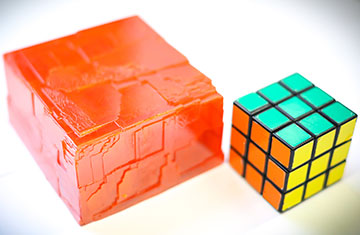
The 3.8 kg CH3NH3PbBr3 crystal growth for high-energy gamma-ray detection. The Rubik’s cube (right) sets the scale. [Image: László Forró (EPFL)]
Gamma-rays, as the shortest-wavelength electromagnetic waves, impart the highest photon energy. Thus these penetrating waves, wherever present, must be closely monitored to prevent damage to living cells.
Toward this goal, researchers in Switzerland and Croatia have developed kilogram-scale perovskite-crystal radiation detectors that feature both high sensitivity and operational stability (Adv. Sci., doi: 10.1002/advs.202001882). The researchers believe that the simple, scalable and affordable fabrication process could potentially solve all of the challenges facing current radiation-detection materials.
High energy, high risk
As evidenced by both fact and fiction, the high-energy photons that make up gamma radiation can damage cells and their genetic material. Take, for example, the radiation sickness suffered by Chernobyl’s first responders, or the green, monstrous aftermath of Bruce Banner’s exposure to a gamma bomb in The Incredible Hulk.
To keep track of these powerful waves—in applications ranging from nuclear power plants and homeland security to environmental monitoring, academic research and even healthcare—cheap, simple and accurate radiation detectors are essential. However, according to Pavao Andričević and his team at Ecole Polytechnique Fédérale de Lausanne (EPFL), Switzerland, crystal detectors on the market today require costly, demanding infrastructures. Metal halide perovskites, on the other hand, meet all the key requirements for radiation detection and can be grown from low-cost, abundant raw materials in solutions at near room temperature—cutting down on both cost and complexity. For these reasons, Andričević says that the crystals “are a game changer in the field of radiation-detection materials.”
Indeed, Andričević says that detecting radiation via perovskite is quite simple—measuring the resistivity of the crystal at room temperature provides a signal that corresponds to the dose-rate of irradiation. Therefore, he explains, “a simple metallic electrode is sufficient to obtain a strong signal under irradiation from a vast range of both energies (visible to high-energy gamma) and dose-rates (down to mGy/h, the dose-rate used in medical purposes).”
Crystal growth
Perovskites have been applied to gamma-ray detection before; however, most crystals grown for this purpose are made using the inverse-temperature crystallization method, which achieves quick growth and perfectly straight edges but limits crystal size to only a few centimeters. The EPFL team added on to this technique in its method, “oriented crystal–crystal intergrowth,” which produces cubic-shape single crystals that are then aligned side-by-side along their facets, like a Rubik’s cube. Then, immersing the crystals in a solution and fusing them together results in a firm connection without inducing any unwanted polycrystallinity.
“With this method we were able to obtain, to the best of our knowledge, by far the largest hybrid perovskite crystal produced so far, reaching the average baby birth weight of 3.8 kg,” says Andričević, adding that there are no technological limitations to exceed this already impressive size.
In experiments, the team irradiated its detector devices with gamma rays at various distances from 25 cm to 125 cm from the source. Changing the distance allowed the team to vary the exposed dose-rate of the samples from 0.07 Gy h−1 to 2.30 Gy h−1. The researchers found that the photodetectors remained stable for up to 100 hours, observing no degradation in this time and demonstrating what the researchers called an unexpectedly high tolerance to gamma radiation. The perovskite-based devices showed comparable sensitivity to market-leading crystals and demonstrated high sensitivity even at low electric fields—which could open up applications in energy-sparse environments, such as in space.
Toward prototypes and future optoelectronics
According to Andričević, this proof-of-concept research shows that perovskites could “potentially solve all challenges of current radiation-detection materials.” In the future, Andričević and his team, want to improve their work and create a working prototype. “The first goal will be to create an electrode design that could allow charge collection from the entire volume of our large crystals, resulting in a further improved signal. In addition, by adding proper electrical hardware to our setup, we will be able to lower the baseline current and noise of the detector, improving the detection limit, which would be of huge interest especially in medical applications.”
Furthermore, Andričević points out, the research could be applied to other longer wavelengths, as perovskites are capable of detecting a wide range of photon energies. The group is already working on developing a perovskite-based neutron detector. And the team’s method for kilogram-scale cystallogenesis of perovskites, he says, coupled with future advances in cutting and slicing could enable crystalline perovskite wafers for various optoelectronic applications.
